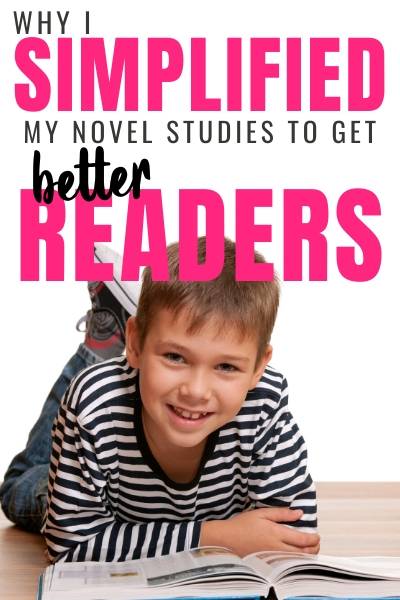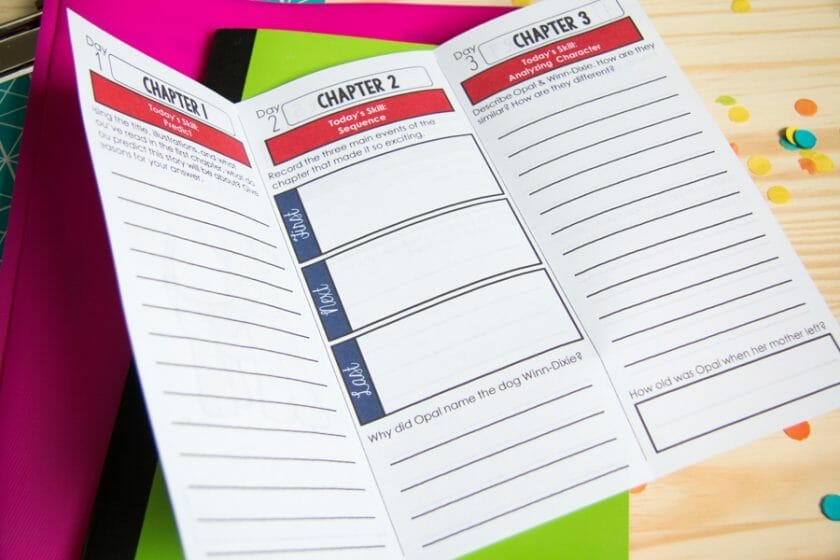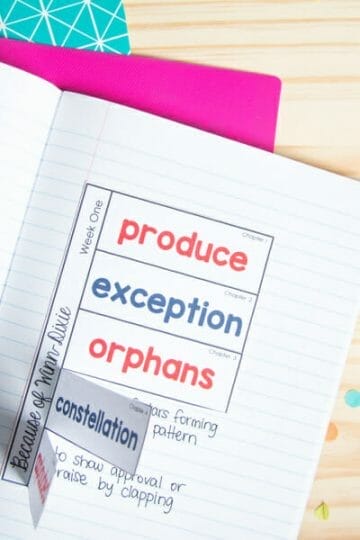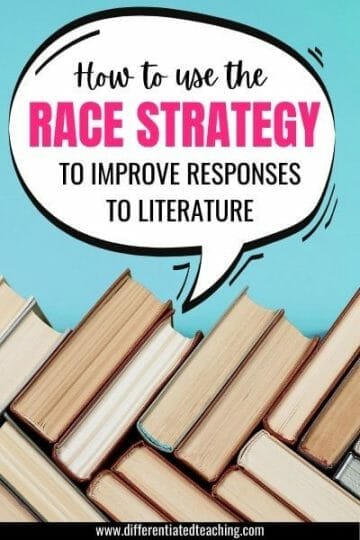From Boring to Brilliant: How Novel Studies Revamped My Reading Lessons
Novel studies sometimes receive an undeserved reputation. In certain educational circles, they’re often viewed as mere entertaining diversions rather than potent, substantive teaching tools. Yet, when used adeptly, novel studies become powerful instruments to support students’ comprehension of chapter books and immerse them in authentic literature.
Let’s embark on a journey where I’ll divulge the art of using novel studies for comprehension skill-building. Drawing from my personal experiences (and a few learning curves!), I’ll spotlight the dos and don’ts, ensuring you maximize this dynamic teaching method. Whether you’re a seasoned reading teacher or a dedicated homeschooler, insights here can revolutionize how you approach reading comprehension. Let’s dive in!

Laying the Groundwork: Elevating Your Approach to Novel Studies for Comprehension
Diving into the world of novel studies for the first time, I admit, I was a tad lost. My initial attempts were met with a mixed bag of results. While the book we chose was a hit, the actual study activities… Well, they left much to be desired.
The room was abuzz with enthusiasm for the story, yet groans filled the air when it came to answering the chapter questions.
And as for grading them? Let’s just say it wasn’t the highlight of my day.
Upon wrapping up the novel, it dawned on me: While my students had a solid grasp of the plot, they struggled to carry forward the comprehension skills we had painstakingly honed.
Sure, they could summarize the day’s reading from our chosen book. But when presented with a fresh text? That ability seemed to vanish, leaving them struggling with other chapter books.
The result? A palpable sense of frustration.
It felt like we had veered off course, losing four precious weeks of potential growth and learning.
But every challenge presents an opportunity, right? And I was determined to make our next foray into teaching to support students’ comprehension a more rewarding endeavor.
Crafting an Innovative Approach: Building Novel Studies for Comprehension Skillbuilding
Taking a step back, I realized the key wasn’t in a long list of chapter questions. It was about digging deeper.
To truly elevate my students’ understanding, it was imperative to anchor our novel studies around critical comprehension skills, pushing past the mere superficial recall of the plot.
I decided to take a leap of faith for our next literary adventure. I ditched the generic chapter questions handed down by well-meaning colleagues and embarked on a mission to start afresh.
My guiding light?
Pinpointing the skills that my students grappled with most during our classes. I was unwavering in my aim to hone in on those challenges, ensuring each learner could master these skills.
And the best part? No more settling for dreary basals; it was all about immersing them in the magic of authentic literature.
Now, I won’t sugarcoat it – the journey was demanding.
Tailoring our novel studies to support students’ comprehension of chapter books was no small feat. I poured over our chosen book, not once, not twice, but thrice, meticulously aligning every lesson. There were moments of doubt, wondering if this new approach would truly make the desired impact. But deep down, I believed in its potential and was ready to take the plunge.
The Triumphant Trifold Transition: Teaching to Support Students’ Comprehension
In crafting that initial novel unit, a glaring problem surfaced: the barrage of daily questions overwhelmed my students.
They were racing against the clock, trying to wrap up before the bell, with genuine comprehension taking a backseat.
It was evident: quantity was overtaking quality.
So, I pivoted. Instead of bombarding them with numerous questions, I zeroed in on a single skill each day, urging them to delve deep into the narrative.
The goal? Facilitate enriching discussions around the text, spotlighting the specific skill of the day rather than a hurried skimming.
That’s when the trifold novel study format came into play, replacing the monotonous comprehension questions. This format reshaped the dynamics of my classroom. The trifolds fostered immersive conversations AND offered skill-building opportunities that stuck with my learners.
The shift was palpable – from cursory answers to sustained comprehension growth.
The trifold’s inviting layout was a game-changer. Students, even those typically overwhelmed by assignments, found the one-skill-a-day approach refreshing and manageable. This newfound clarity let me challenge them further, nudging them to delve deeper into their analyses.
Before I knew it, I didn’t have to prod them to connect their answers with the text. They instinctively sought text evidence, bolstering their responses with concrete proof.
Discussions brimmed with enthusiasm, and on particularly electric days, they’d challenge each other’s interpretations, craving more depth.
Perfect? Maybe not. But miles ahead of those dreary, disconnected passages we’d previously waded through.

Game-Changing: Why I Love Trifold Novel Studies for Comprehension Skill-building
You know, there’s something magical about diving into a good book with students. And when I started pairing this joy of reading with trifolds for our novel studies… Well, that magic just grew tenfold.
Forget those dusty old textbooks that can make reading a chore. With a good story and our handy trifolds, the kiddos get lost in a world of imagination and pick up some seriously useful comprehension skills along the way.
You might be wondering, what are the benefits of a novel study like this?
Here’s a breakdown of why I’m such a big fan of trifold novel studies:
1. Eco-friendly learning.
The trifold format is impressively paper-saving.
In my first year of teaching, we had to submit our copy requests at least a month in advance. In fact, we weren’t even allowed to know where the copy machine was in the building. Needless to say, I spent many nights running to the copy shop near my apartment to get what I needed for my students.
While I am no longer on a paper budget, I do remember the days when I worked in a school that was. Being able to assess students’ reading comprehension across an entire novel in just a few pieces of paper per student? Priceless.

2. Universally engaging & laser-focused on skill development.
Remember those overwhelmed faces at the sight of a dense worksheet? The trifold’s design eases this.
By folding the paper, each day’s task stands alone, which is especially beneficial for students who:
- Get overwhelmed easily.
- Tend to drift off-task.
- Find transitions between tasks challenging.
- Might be struggling readers or writers.
- Are on a quest for a deep dive into specific reading comprehension skills.
With each chapter of a novel bursting with chances for teaching and supporting students’ comprehension of chapter books, it’s tempting to tackle all at once. But, this often results in a superficial grasp.
The trifold ensures we zoom in on a specific comprehension skill daily, facilitating a deeper understanding and allowing me to easily differentiate to meet students where they are while teaching to support students comprehension. While discussions might sway towards other book-related aspects, my primary lesson and evaluation remain rooted in the day’s targeted strategy.

3. Built-in spiraling.
Trifold novel studies are fantastic for novel studies for comprehension skill-building over time. Skills like discerning the main idea or crafting a summary benefit from repetition. With students’ growing familiarity with the book’s characters and plot, revisiting these skills becomes a more intuitive process.
In short, trifolds have transformed how I conduct novel studies, optimizing teaching and learning in an engaging, efficient, and effective way.
Diving Deeper: A Peek Inside My Trifold Novel Study Activities
So I’ve been chatting your ear off about why I’m head over heels for trifold novel studies. But let’s get down to the nitty-gritty. What do these activities actually look like, and how do they roll out in the classroom?
Okay, friends, let me take you on a little journey to Naomi, Florida. If you haven’t had the pleasure of diving into Because of Winn-Dixie by Kate DiCamillo with your students, boy, are you in for a treat!
This book isn’t just a heartwarming story about a girl and her dog – it’s a treasure trove of teaching opportunities. With its intricately woven characters and the atmospheric setting, there’s a richness in the narrative that’s just perfect for in-depth exploration. And let’s not even get started on the vocabulary! How often do you get to introduce your kiddos to scrumptious words like “melancholy”?
So, how does this all translate to our trifold novel study activities?
Designed for Learning: Because of Winn-Dixie in Focus
Picture this: each section is neatly broken down for every day of the week to support students comprehension of chapter books, ensuring a consistent and in-depth exploration of the text. At the top, you’ll spot which chapters the students should be diving into and which skill they’ll hone that day.
Let’s zone in on Day 3 of my Because of Winn-Dixie Novel Study. On this delightful day, students get to explore Opal and Winn-Dixie’s character traits.
The focus?
Comparing and contrasting our lovable protagonists. This isn’t just a skim-the-surface activity. It nudges students to engage with the text, pulling out evidence to paint a vivid picture of each character’s unique traits.

To help them navigate this, we often kick off with an anchor chart. Before diving into comparisons, it’s all about understanding each character in isolation.
My go-to? A web graphic organizer.
It’s a simple yet effective way to let ideas flow and expand as we journey through the chapters. And believe me, these webs grow richer, fuller, and more insightful as the pages turn.

One Word Wonders: When Less is More with Vocabulary
Let’s talk vocabulary. When diving into a novel, it’s oh-so-tempting to bombard our eager learners with a slew of new words. But here’s a little secret I’ve stumbled upon in my years of teaching: Less is more. Yup, you read that right!
In my trifold novel studies, I zero in on just one standout word from the text each day rather than overwhelming my kiddos with a cascade of terms. And trust me, this singular focus makes all the difference.
Picture it: About 10 minutes, one word, and a room buzzing with curiosity. Together, we roll up our sleeves and delve deep into that word’s world.
What does it mean?
Can we craft a sentence around it?
Are there any cousins or siblings to this word lurking in our brains?
These daily vocab sessions aren’t just about adding to our word bank; they’re about creating a rich tapestry of understanding and connection around each term.
But wait, there’s more!
We tuck these words into a flipbook to give them a permanent cozy home. This isn’t just any flipbook. It’s a growing testament to our vocabulary adventures, which students proudly nestle into their reading journals.
Over time, as they flip through, they’re not just revisiting words – they’re journeying through memories of stories, lessons, and lightbulb moments. How’s that for making vocabulary stick?

Unlocking the Magic of Comprehension with Novel Studies
Let’s take a moment to reflect. We’ve ventured deep into the world of novel studies, peeled back the layers of trifolds, and seen how they can transform the reading experience for our students. We’ve shared a few laughs over copy machine fiascos and marveled at the depth of vocabulary in our favorite books.
But at the heart of it all?
It’s about nurturing a love for reading while equipping our young readers with the skills they need to journey through any story. It’s about striking that sweet balance between enjoyment and education. Remember, with the right resources (hello, novel studies!) and a touch of passion, we can inspire a new generation of book lovers.
Whether you’re a seasoned novel study pro or just dipping your toes into these waters, know you’re doing something special. Every page turned, every word explored, and every connection made is a step towards creating confident, compassionate readers.
So, let’s embrace the adventure, shall we? Because in the world of teaching, every book is a new beginning, every lesson a new story. And together, we’re writing a tale of success, one reader at a time.







